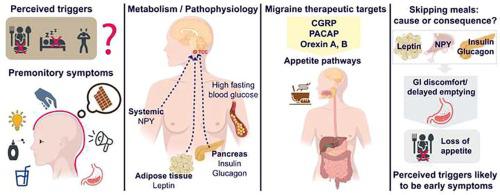Brain Research ( IF 2.7 ) Pub Date : 2021-08-21 , DOI: 10.1016/j.brainres.2021.147629 Margarida Martins-Oliveira 1 , Isaura Tavares 2 , Peter J Goadsby 3

|
Migraine attacks can involve changes of appetite: while fasting or skipping meals are often reported triggers in susceptible individuals, hunger or food craving are reported in the premonitory phase. Over the last decade, there has been a growing interest and recognition of the importance of studying these overlapping fields of neuroscience, which has led to novel findings. The data suggest additional studies are needed to unravel key neurobiological mechanisms underlying the bidirectional interaction between migraine and appetite. Herein, we review information about the metabolic migraine phenotype and explore migraine therapeutic targets that have a strong input on appetite neuronal circuits, including the calcitonin gene-related peptide (CGRP), the pituitary adenylate cyclase-activating polypeptide (PACAP) and the orexins. Furthermore, we focus on potential therapeutic peptide targets that are involved in regulation of feeding and play a role in migraine pathophysiology, such as neuropeptide Y, insulin, glucagon and leptin. We then examine the orexigenic - anorexigenic circuit feedback loop and explore glucose metabolism disturbances. Additionally, it is proposed a different perspective on the most reported feeding-related trigger - skipping meals - as well as a link between contrasting feeding behaviors (skipping meals vs food craving). Our review aims to increase awareness of migraine through the lens of appetite neurobiology in order to improve our understanding of the earlier phase of migraine, encourage better studies and cross-disciplinary collaborations, and provide novel migraine-specific therapeutic opportunities.
中文翻译:

是我吃的东西吗?了解偏头痛和食欲神经回路的双向相互作用
偏头痛发作可能涉及食欲的变化:虽然经常报告易感个体的禁食或不进餐触发因素,但在前兆阶段报告了饥饿或食物渴望。在过去的十年中,人们对研究这些重叠的神经科学领域的重要性越来越感兴趣并认识到了这一点,这导致了新的发现。数据表明,需要更多的研究来揭示偏头痛和食欲之间双向相互作用的关键神经生物学机制。在此,我们回顾了有关代谢性偏头痛表型的信息,并探索了对食欲神经元回路有重要影响的偏头痛治疗靶点,包括降钙素基因相关肽 (CGRP)、垂体腺苷酸环化酶激活多肽 (PACAP) 和食欲素。此外,我们专注于参与调节喂养并在偏头痛病理生理学中发挥作用的潜在治疗性肽靶点,例如神经肽 Y、胰岛素、胰高血糖素和瘦素。然后我们检查促食欲-厌食回路反馈回路并探索葡萄糖代谢紊乱。此外,对报告最多的与进食相关的触发因素 - 不吃饭 - 以及对比进食行为(不吃饭与对食物的渴望)之间的联系提出了不同的看法。我们的审查旨在通过食欲神经生物学的视角提高对偏头痛的认识,以提高我们对偏头痛早期阶段的理解,鼓励更好的研究和跨学科合作,并提供新的偏头痛特异性治疗机会。











































 京公网安备 11010802027423号
京公网安备 11010802027423号